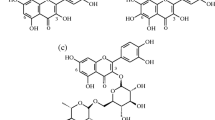Abstract
Recently there has been a moderate resurgence in the use of flax-seed in a variety of ways including bread. The scientific basis of its use is very limited. There is some claim for beneficial effects in cancer and lupus nephritis. These claims could be due to its ability to scavenge oxygen radicals. However, its antioxidant activity is not known. Recently a method has been developed to isolate secoisolariciresinol diglucoside (SDG) from defatted flax-seed in large quantity (patent pending). We investigated the ability of SDG to scavenge úOH using high pressure liquid chromatography (HPLC) method. úOH was generated by photolysis of H2O2 (1.25-10.0 \sgmaelig;moles/ml) with ultraviolet light and was trapped with salicylic acid which is hydroxylated to produce úOH-adduct products 2,3-dihydroxybenzoic acid (DHBA) and 2,5-DHBA. H2O2 produced a concentration-dependent úOH as estimated by 2,3-DHBA and 2,5-DHBA. A standard curve was constructed for known concentrations of 2,3-DHBA and 2,5-DHBA against corresponding area under the peaks which then was used for measurement of 2,3-DHBA and 2,5-DHBA generated by UV irradiation of H2O2 in the presence of salicylic acid. SDG in the concentration range of 25, 50, 100, 250, 500, 750, 1000 and 2000 \sgmaelig;g/ml (36.4, 72.8, 145.6, 364.0, 728.0, 1092.0, 1456.0 and 2912.0 \sgmaelig;M respectively) produced a concentration-dependent decrease in the formation of 2,3-DHBA and 2,5-DHBA, the inhibition being 4 and 4.65% respectively with 25 \sgmaelig;g/ml (36.4 \sgmaelig;M) and 82 and 74% respectively with 2000 \sgmaelig;g/ml (2912.0 \sgmaelig;M). The decrease in úOH-adduct products was due to scavenging of úOH not and by scavenging of formed 2,3-DHBA and 2,5-DHBA. SDG prevented the lipid peroxidation of liver homogenate in a concentration-dependent manner in the concentration range from 319.3-2554.4 \sgmaelig;M. These results suggest that SDG scavenges úOH and therefore has an antioxidant activity.
Similar content being viewed by others
References
Carter J: Flaxseed as a source of alpha-linolenic acid. J Am Coll Nutr 12: 551, 1993
Cunnane SC, Ganguli S, Menard C, Liede AC, Hamadeh MJ, Chen ZU, Wolever TMS, Jenkins DJA: High alpha-linolenic acid flaxseed (Linum usit atissimum): Some nutritional properties in humans. Brit J Nutr 69: 443–453, 1993
Kelley DS, Branch LB, Love JE, Taylor PL, Rivera YM, Iacono JM: Dietary alpha linolenic acid and immunocompetence in humans. Am J Clin Nutr 53: 40–46, 1991
Hunter JE: N-3 fatty acids from vegetable oils. Am J Clin Nutr 51: 809–814, 1990
Exler J, Weihrauch JL: Provisional table on the content of n-3 fatty acids and other fat components in selected foods. Washington, DC: US Department of Agriculture, 1985 (Publication HNIS/PT-103)
Bakke JE, Klosterman HJ: A new diglucoside from flaxseed. Proc North Dakota Acad Sci 10: 18–22, 1956
Axelson M, Sjövall J, Gustaisson BE, Setchell KDR. Origin of lignans in mammals and identification of a precursor from plants. Nature 298: 659–670, 1982
Serraino M, Thompson LU: The effect of flaxseed supplementation on early risk markers for mammary carcinogenesis. Cancer Lett 63: 135–142, 1991
Hall AV, Parbtani A, Clark WF, Spanner E, Keeney M, Chin-Yee I, Philbrick DJ, Holub BJ: Abrogation of MRL/lpr lupus nephritis by dietary flaxseed. Am J Kidney Dis 22: 326–332, 1993
Clark WF, Parbtani A, Huff MW, Spanner E, DeSalis H, Chin-Yee I, Philbrick DJ, Holub BJ: Flaxseed: A potential treatment for lupus nephritis. Kidney Internatl 48: 475–480
Menkes MS, Comstock GW, Vuilleumier JP, Helsing KJ, Rider AA, Brookmeyer R: Serum beta-carotene, vitamins A and E, selenium and the risk of lung cancer. N Engl J Med 315: 1250–1254, 1986
Cook MG, McNamara P: Effect of dietary vitamin E on dimethylhydrazine-induced colonic tumors in mice. Cancer Res 40: 1329–1331, 1980
Horvath PM, Ip C: Synergistic effect of vitamin E and selenium in the chemoprevention of mammary carcinogenesis in rats. Cancer Res 43: 5335–5341, 1983
Willett WC, Polk BF, Underwood BA, Stampfer MJ, Pressel S, Rosner B, Taylor JO, Schneider K, Hames CG: Relation of serum vitamins A and E and carotenoid to the risk of cancer. N Engl J Med 310: 430–434, 1984
Prasad K, Laxdal VA: Hydroxyl radical-scavenging property of indomethacin. Mol Cell Biochem 136: 139–144, 1994
Prasad K, Laxdal VA, Yu M, Raney BL: Antioxidant activity of allicin an active principle in garlic. Mol Cell Biochem 148: 183–189, 1995
Floyd RA, Henderson R, Watson JJ, Wong PK: Use of salicylate with high pressure liquid chromatography and electrochemical detection (LCED) as a sensitive measure of hydroxyl radical in adriamycintreated rats. Free Rad Biol Med 2: 13–18, 1986
Prasad K, Laxdal VA, Yu M, Raney BL: Evaluation of hydroxyl radical scavenging property of garlic. Mol Cell Biochem 154: 55–63, 1996
Mak IT, Boehme P, Weglicki WB: Antioxidant effects of calcium channel blockers against free radical injury in endothelial cells: correlation of protection with preservation of glutathione levels. Circ Res 70: 1099–1103, 1992
Prasad K, Gupta JB: Influence of hydroxyl radical on rabbit airway smooth muscle chronically exposed to H2O2 in vivo. Am J Physiol 264: L566–L574, 1993
Ohkawa H, Ohishi N, Yagi K: Assay for lipid peroxides in animal tissue by thiobarbituric acid reaction. Anal Biochem 95: 351–358, 1979
Kapoor R, Prasad K: Role of oxyradicals in cardiovascular depression and cellular injury in hemorrhagic shock and reinfusion: Effect of SOD and catalase. Circ Shock 43: 79–94, 1994
Onodera T, Ashraf M: Detection of hydroxyl radicals in post-ischemic reperfused heart using salicylate as a trapping agent. J Mol Cell Cardiol 23: 365–370, 1991
Gutteridge JMC: Lipid peroxidation: Some problems and concepts in oxygen radicals and tissue injury. Proceeding Upjohn Symposium (Ed. by B. Halliwell) 1988; pp 9–19
Author information
Authors and Affiliations
Rights and permissions
About this article
Cite this article
Prasad, K. Hydroxyl radical-scavenging property of secoisolariciresinol diglucoside (SDG) isolated from flax-seed. Mol Cell Biochem 168, 117–123 (1997). https://doi.org/10.1023/A:1006847310741
Issue Date:
DOI: https://doi.org/10.1023/A:1006847310741




